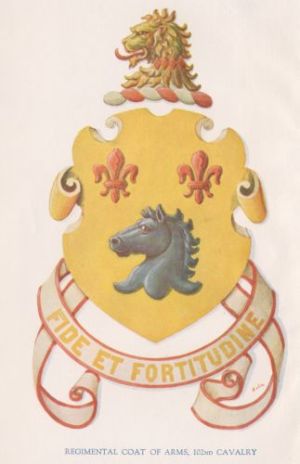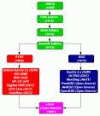HISTORY OF THE ESSEX TROOP
 Coat of Arms of the Essex Troop CHAPTER I (pg 3-10) THE ESSEX TROOP ORGANIZED The Essex Troop of to-day is the fruit of a tree that took root fortuitously in 1890 and that has grown gradually but surely ever since. Many events in the history of the community and of the nation-of the world even-have influenced its development and it is the purpose of this work to recall, rather briefly, some of the incidents that were of the essence of the organization's life. Formation of the Troop was an answer to the need for a body of horsemen ready and willing to participate in various civil functions in Newark. This need, only half expressed at first, crystallized and the Troop developed into an organization in many ways representative of the best in the social, civil and military life of Essex County. The actual formation of the Troop was due to an unexpected occurrence in May, 1890. The occasion was the unveiling of a statue of Seth Boyden in Washington Park. Colonel James E. Fleming had been chosen grand marshal of the parade and had intended selecting his aides and staff from among the local trade organizations. The night but one before the day for the ceremonies, Colonel Bassett, president of the Board of Trade, informed Colonel Fleming that through some misunderstanding these aides would not be available, and asked him what could be done to provide a suitable escort for the speaker, Chancellor Runyon, and the other dignitaries attending. "Leave it to me. We will have the parade," Colonel Fleming replied. That same night he sent a request to each of a dozen members of the Essex Club requesting them to meet him the next day at the Park, suitably mounted. These men substituted for the members of the trades unions and the parade was carried off in a creditable manner. Following the ceremonies, the horsemen re-assembled at the Essex Club for luncheon, where Colonel Fleming remarked that it was unfortunate that Newark did not have an organi- zation that could be depended upon for such an occasion as that in which they had just taken part. "What kind of an organization would Colonel Fleming suggest," Chauncey G. Parker asked. To which the Colonel replied, "A mounted body, a troop of cavalry." It was proposed by Rowland P. Keasbey that Colonel Fleming draw up a call for a meeting to consider organizing such a body. This was done at once and signed by Messrs. Fleming, Parker and Keasbey and put in the printer's hands the same afternoon. Between fifty and sixty copies of the call were sent out. It read as follows: "A number of gentlemen of this city propose organizing a troop of cavalry, and with that object in view a meeting will be held at the rooms of the Board of Trade, June 3, 1890, at eight p. m., to which you are cordially invited. Should you be unable to attend in person, please signify on or before that date your desire to become a member." The meeting was held on the date fixed with R. Wayne Parker presiding, and Frederick B. Young as secretary. About fifty men attended, of whom over forty enrolled and signed the following pre- amble: "We, the officers and members of the Essex Troop of Light Cavalry, do solemnly agree to the following rules for our govern- ment, and to such others as may be hereafter passed as prescribed, and which are not contrary to the Constitution and Laws of this State or of the United States, and we do hereby pledge our honor, of which our signature is witness, that we will to the best of our ability and understanding, devote ourselves, by all honorable means, and ardently co-operate in the increase of its strength, respectability and discipline; and that we will foster and maintain sentiments of regard and affection towards each other, as soldiers and citizens, and united as a band of brothers, devote ourselves when occasion requires it, to the service of our country." Colonel Fleming was unanimously elected captain of the newly formed Essex Troop, and given power to appoint committees on constitution, by-laws, permanent organization, drill rooms, arms and equipment and application for membership. The following officers and non-commissioned officers were appointed: First Lieutenant, Frederick Frelinghuysen Other charter members were:
The Essex Troop became the pride of Colonel Fleming, and it was to his imagination, unfailing zeal, and qualities as a leader that the organization was much indebted in the early years of its history. The Colonel was a natural leader of men. He won affection at the same time as he commanded respect. It is hardly too much to say that the form and characteristics of the organization were moulded to a great extent by its first leader and that the high standard of work and the reputation it afterward earned were in large measure due to his ideals. Colonel Fleming was born in Warren, Ohio, July 24, 1836, his family previously having resided in Pennsylvania, where it had been prominent for more than a century. He was descended from the Scottish Earls of Wigton. His mother was a bril- liant horsewoman and he came naturally, therefore, by his love and knowledge of horses. When the Civil War broke out he was studying law in Philadelphia. He at once organized a body of cavalry, took it to Washington and received his assignment to Harlan's 11th Pennsylvania Cavalry. On May 30, 1862, he was captured and confined in Salisbury, N. C., and later in Libby Prison. Escaping, he served on the staffs of General Alfred Gibbs and Brigadier-Gen- erals Terry and Wister. He accompanied General Wister when the latter made his celebrated dash to capture Jefferson Davis in Richmond. He served with distinction on the staffs of several Generals and was wounded a number of times, finally being forced February 13, 1865, to resign, because of his injuries. Colonel Fleming served as commander of the Essex Troop until June, 1895, when he resigned from the active command. He was elected honorary captain and maintained an active interest in the organization until he died in Newark, April 10, 1909. Some highlights: Pg 17. Feb 15, 1893. Fifty members of the Essex Troop approved a concept bill to give the Legislature the authority to add two cavalry troops to the National Guard. Feb 21, 1893. Bill introduced into the State Senate. It passed both houses, and was signed by Governor Werts a few weeks later May 17, 1893. Essex Troop mustered into the National Guard. Pg 19 June 1894 Troop's Name changed from Cavalry Company A to The First Troop, National Guard of New Jersey. Pg 20 Aug 9, 1894 Statue of Frederick Frelinghuysen unveiled in Military Park, Newark. Pg 27 1897 The Roseville Riding Acadamy becomes the Troop's Armory. It soon proves too small, and eventually (in 1908) a new (state-owned) Armory was completed. Pg 33 Due to an error, the Essex Troop did not participate in the Spanish-American War. Pg 39 Jun 1902 The Essex Troop participates in control after the Paterson fire Eventually the troop goes up into the NJ National Guard, and goes on to win many honors in both WWI and WWII For more information see: Old Newark.com's Essex Troop History Essex Troop 102nd Cavalry Regiment Association |
 The Ancestors of My Grandchildren
The Ancestors of My Grandchildren
Seidler - Broekman Genealogy